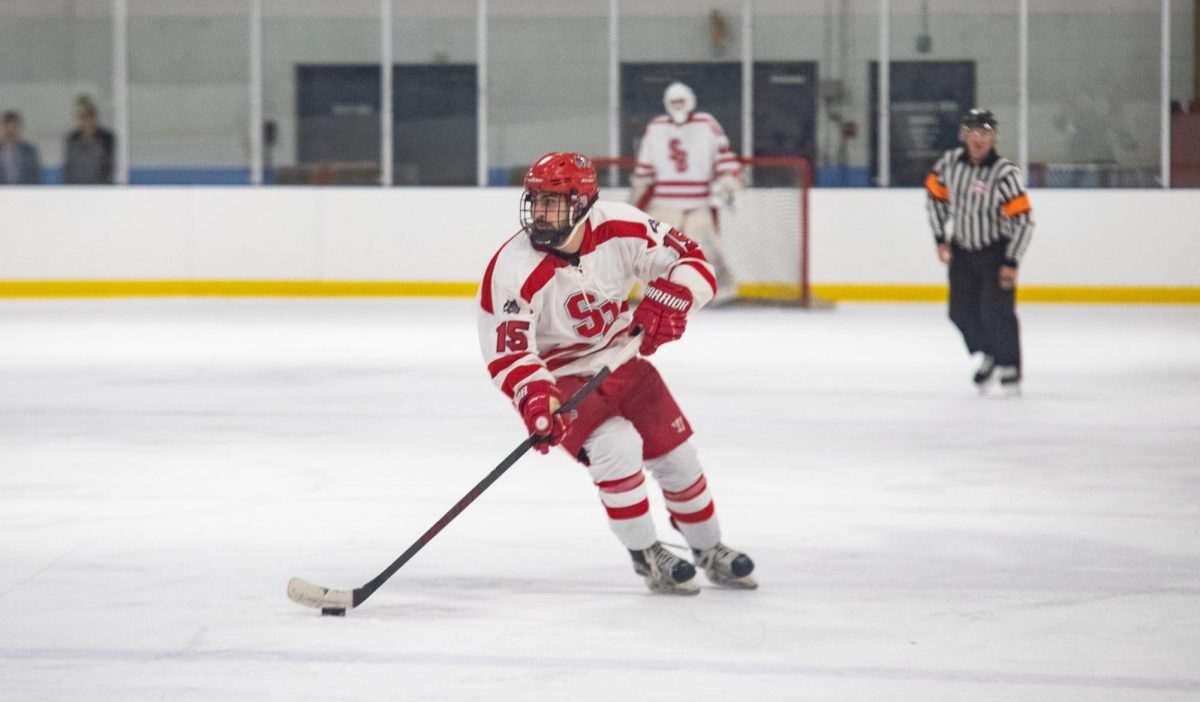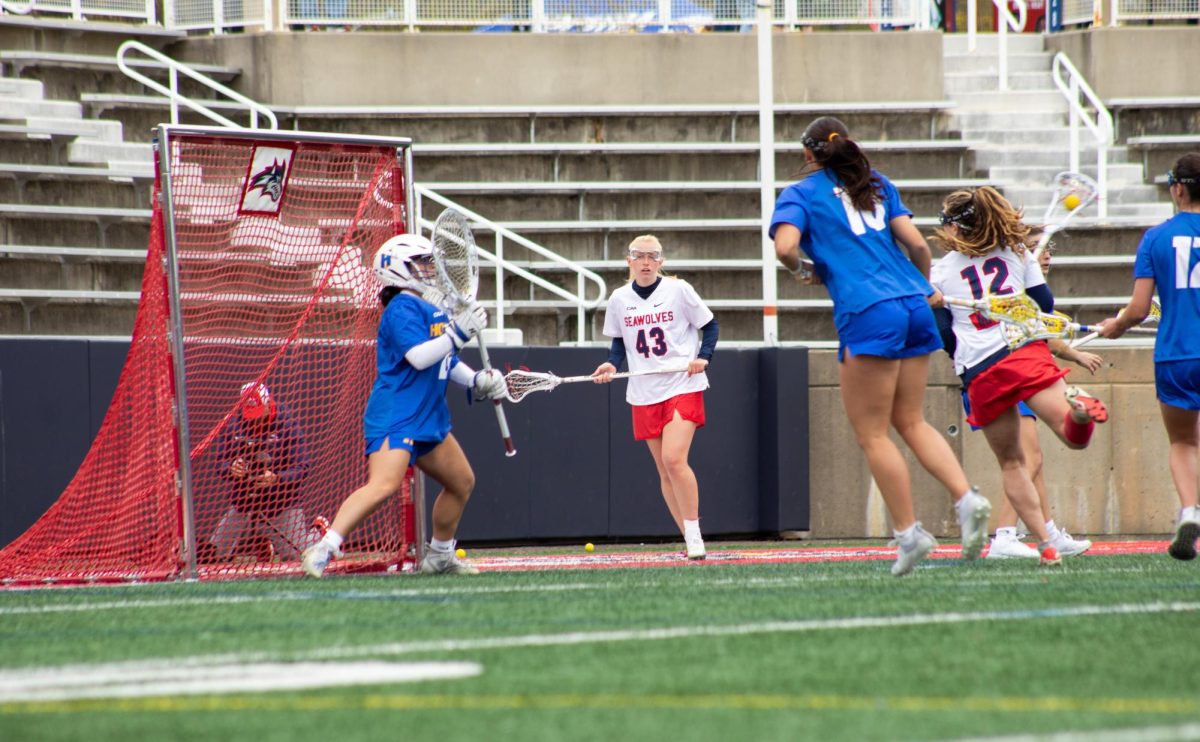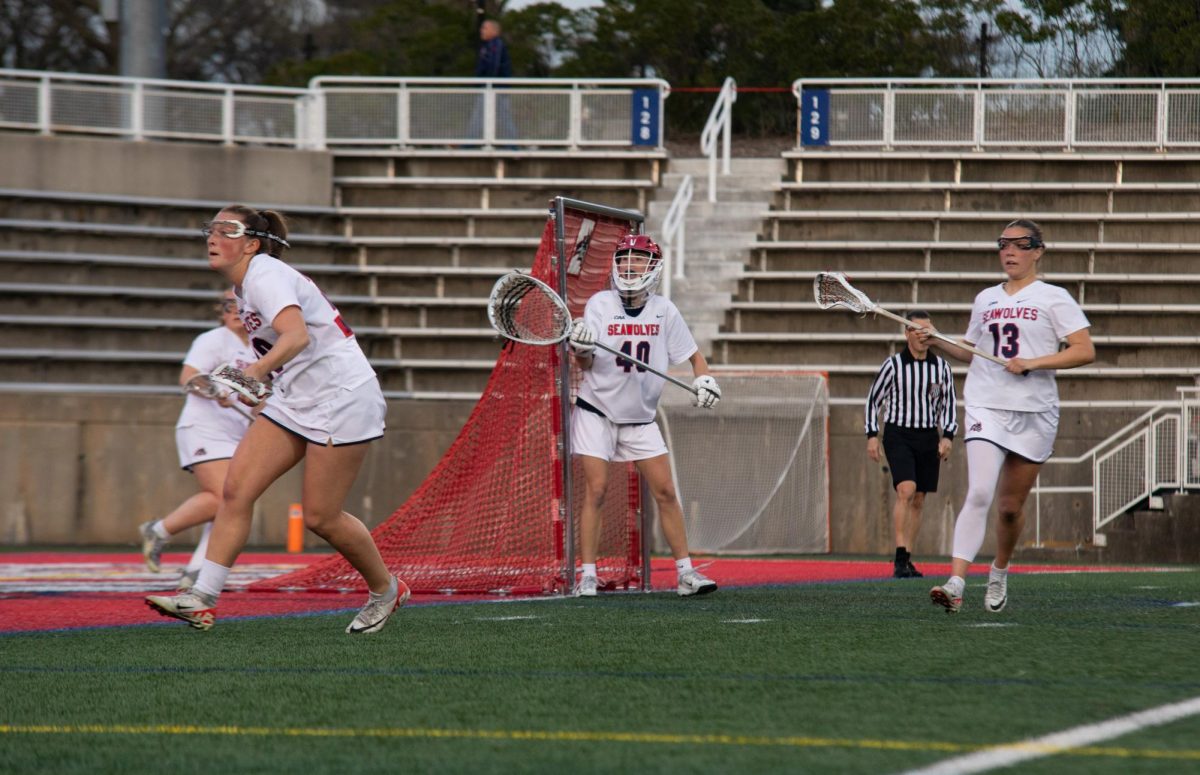
After winning the 2021-22 Eastern States Collegiate Hockey League (ESCHL) title and making it to the second round of the national tournament, the Stony Brook club hockey team entered the 2022-23 season with championship expectations. However, the Seawolves learned the hard way that living up to expectations is much easier said than done.
Heading into this past season, Stony Brook’s roster from the previous year was kept largely intact. The Seawolves were set to lose three of their top players in defenseman Brendan Pepe and forwards Chuckie Peck and Joey Slevin, but head coach Chris Garofalo believed that the team’s depth remained very strong.
Unfortunately, Stony Brook took a step back. Though it entered the year ranked No. 6 in the nation, the team dropped to 18 by season’s end. The Seawolves still had a respectable year, finishing 18-11-4 overall while going 7-5-2 in ESCHL games. Against American Collegiate Hockey Association (ACHA) opponents, they went 17-11-4 and picked up an extra win in an exhibition game against Manhattanville — an NCAA Division III school.
Stony Brook’s struggles in league games plummeted it to fourth place in the ESCHL standings, preventing the team from earning an automatic bid to the 2023 ACHA National Tournament. That forced the Seawolves to rely on their national ranking. However, they were ranked only 18th in the nation, which was not high enough to make nationals. They were bumped from the tournament in favor of Indiana University of Pennsylvania, who clinched an automatic bid as the College Hockey Mid-America conference champions.
It was the first time that Stony Brook had missed the ACHA National Tournament since the 2011-12 season, and only the second time in the past 23 seasons.
“Wanting to do something and understanding what it takes to do something are two different things,” Garofalo said in an interview with The Statesman. “We have to be better in understanding that as a team, it’s not just showing up that is going to make us win. It’s consistency in our game. It’s a tremendous amount of effort. It’s doing the little things away from the rink and on the ice.”
Stony Brook got off to a white-hot start, winning its first eight games. Following their torrid start, the Seawolves found themselves in a slog, fluctuating between being a contender and being a pretender. The team was plagued with injuries throughout the season, which greatly contributed to the 10-11-4 finish. The biggest loss Stony Brook suffered was during winter break when left winger Brandon Avezov — the team’s leading scorer — transferred to Columbia.
Just about every single one of Stony Brook’s top-line guys missed time with injuries or other personal issues. Center Mike Conlin joined the team halfway through the season and suffered a season-ending concussion at Ohio. Center Greg Barnych suffered a knee injury that lingered throughout the year, derailing what was a very good start to his season.
After playing in the first five games of the season, left winger Matt Minerva missed the rest of the first half of the season. While practicing before his return to the ice, he suffered a separated shoulder during that time. After coming back in the second half of the season and making an instant impact, he sprained his ankle against Delaware and missed the next two series.
Defensemen and alternate captains Rob Distefano, Andrew Mancini and Davin Van de Zilver all missed a lot of time as well. Distefano broke his hand before the Davenport series and suffered a knee injury during the ESCHL playoffs. Van de Zilver missed three games early in the season due to a bone bruise on his foot and missed time in the second half of the season while nursing a torn shoulder labrum.
Team captain and right winger Devin Pepe said these injuries waylayed the Seawolves’ early-season momentum.
“Obviously, we had a great start, winning a bunch,” Pepe said. “And then throughout the year, it felt like we were getting hit with injury bugs left and right and not always having our full lineup … we had some good performances, but we just were not consistent.”
Along with missing some key pieces and delivering inconsistent efforts, multiple players mentioned locker room issues as being a problem throughout the season. Van de Zilver, who finished up his final season with the team, said that the team did a poor job overcoming its problems.
“We didn’t tackle the adversity the best way possible at all times,” Van de Zilver said. “Sometimes, we took the easier route instead of taking it head on and I think that, in the future, the guys will definitely be able to handle that.”
Goaltender Matvei Kazakov shared this sentiment, stating that steps can be taken to improve the culture in the locker room and bring the team closer together.
“It’s college hockey and people come and go,” Kazakov said. “You have to come together as a team pretty quickly. I think we could have done a slightly better job this year in that term … I think we will do a better job in team bonding.”
Unlike last season, Stony Brook did not win as many games as it was supposed to. Throughout the campaign, the Seawolves suffered several upsets to inferior teams, such as New York University (NYU) and Drexel.
Garofalo said that these letdown games were a wake-up call for the program moving forward.
“We weren’t used to struggling against certain teams and we were,” Garofalo said. “When that happened, we didn’t understand how to adapt but now I think we have that understanding and I do not think we are going to take any teams lightly. Everybody has gotten a little bit of a wake up call, including myself … we had a little bit of assumptiveness in us and it caught up to us.”
Stony Brook’s 5-4 shootout loss to Drexel on Feb. 4 is what ultimately did the team in, as it sparked a five-game losing streak that put its national tournament hopes to bed. The Seawolves went on to be swept by Rhode Island and Niagara in back-to-back series following the loss.
Stony Brook did a mediocre job defending its home ice, going just 6-5-2 when playing at The Rinx and Clark Gillies Arena. However, the team was much better on the road, going 12-6-2 away from home.
Garofalo said that the different levels of success stemmed from better focus while away from home.
“When you are home, there are a lot of distractions and when you are away, there are no distractions,” Garofalo said. “Everything is about the game and the team on the road, so I do not think the focus was there as much at home.”
On the ice, Stony Brook’s biggest inconsistency was its special teams. The Seawolves power play struggled mightily, clocking in at just 17.2%, but their penalty kill was the 11th-best in the ACHA at 84.4%.
Distefano said that the two units had different levels of pride, leading to a large disparity in performance.
“When you don’t score on the power play, it’s more like ‘We’ll get them next time,’” Distefano said. “But when you give up a goal on the penalty kill, it feels like it is all on you. It’s way heavier of an outcome … That drives a lot of our guys to sacrifice anything to make sure they do not score. I feel like, on our team, the penalty kill is a big part of our culture.”
Over the course of the season, the Seawolves had a number of standout performers. Following Avezov’s departure, Barnych and Minerva led the way for the Seawolves. Barnych finished the season with 27 points, good enough for second on the team.
Minerva only played 16 games, but he made his presence felt. In the small sample size, Minerva scored 11 goals and totaled 25 points, giving him the second best points per game clip on the team.
Kazakov was far and away the team’s best and most consistent player. He posted a solid .911 save percentage and two shutouts. He kept Stony Brook in most of the games that he started.
Despite his stellar play, Kazakov believes that he let the team down at times, mentioning that his endurance was lacking. He plans to increase his cardio during the offseason to help improve it.
“I want to become a little bit faster,” Kazakov said. “This season showed me that if we have some bad streak or I have a streak of like, five to eight games in a row, I am supposed to stay fresh until the end of the game. That’s where I can improve my conditioning and cardio.”
Along with the usual notable top performers, the Seawolves also had a number of breakout players this season. Garofalo commended the play of several players, such as right winger Nick Zarrilli, left winger Matteo Daita and defensemen Spencer Boris, Aidan Gallagher and Brendan Fess.
Though the aforementioned players received a ton of credit, Garofalo praised right winger Will Kormanik the most. The freshman finished the season as the team’s third-leading scorer with 26 points.
Distefano glowed about Kormanik and his work ethic.
“Give that kid a year or two and he is going to run the league,” Distefano said. “As a freshman, he was one of our best forwards and he is one of those guys that puts in the work.”
Left winger Kristian Malec is another freshman who made an impact. He started off slowly this past year, but finished the season on a high note. He received high praise from Mancini.
“He is a great hockey player as well and he brings a lot of value to the table,” Mancini said. “Throughout the season, he started to find his way through and had his feet moving towards the end of the year so I’m excited to see how he does moving forward.”
Heading into next season, Stony Brook’s roster will go through immense amounts of change. The team is graduating several key defensemen, such as Dom Molfetto, Matt McDermitt and Van de Zilver. Backup goaltender Thomas Sullivan is also out of eligibility. Center Conor Dempsey and wingers Mike Galinski, Filip Pomianek and Shawn Rainville will all graduate as well.
Pepe and center Jesse Edwards will likely return while attending graduate school, but that is not yet confirmed. Distefano is still in the process of making his decision, though both he and Garofalo have said that he is most likely moving on.
To offset the big losses going into next season, Garofalo mentioned that returning players will need to step up, but recruiting is the most important aspect in building a winner.
“Guys have to step up and guys have to come in and that’s where recruiting starts,” Garofalo said. “Winning does not start on the ice, it starts on the phone.”
Going into next season, Stony Brook will look to return to its former glory and put the 2022-23 season behind it. Despite still being ranked in the top 20, Garofalo said that No. 18 is too low for Stony Brook’s standards.
“For the organization and the program, there are teams in this country that would die to be number 18, that would love to be number 18,” Garofalo said. “But for our standards here, to us, it was not a success because we are a better team than 18 … we will be back stronger and better next year.”
Alex Streinger also contributed reporting.



















